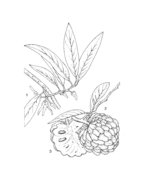Annona squamosa
Description
-
1, flowering branch; 2, branch with fruit (pseudocarp); 3, halved fruit (PROSEA)
Popular names
Classification
Cultivars
History
Uses
Anona asiatica. Ceylon and cultivated in Cochin China. The oblong-conical fruit, red on the outside, is filled with a whitish, eatable pulp but is inferior in flavor to that of A. squamosa.
Anona cinerea Dunal. ANON. SUGAR APPLE. SWEETSOP. West Indies. This species is placed by Unger [1] among edible fruit-bearing plants.
- ↑ Unger, F. U.S. Pat. Off. Rpt. 350. 1859.
Anona squamosa Linn. ANON. SUGAR APPLE. SWEETSOP. It is uncertain whether the native land of this tree is to be looked for in Mexico, or on the plains along the mouth of the Amazon. Von Martius [1] found it forming forest groves in Para. It is cultivated in tropical America and the West Indies and was early transported to China, Cochin China, the Philippines and India. The fruit is conical or pearshaped with a greenish, imbricated, scaly shell. The flesh is white, full of long, brown granules, very aromatic and of an agreeable strawberrylike, piquant taste [2]. Rhind [3] says the pulp is delicious, having the odor of rose water and tasting like clotted cream mixed with sugar. Masters [4] says the fruit is highly relished by the Creoles but is little esteemed by Europeans. Lunan [5] says it is much esteemed by those who are fond of fruit in which sweet prevails. Drury [6] says the fruit is delicious to the taste and on occasions of famine in India has literally proved the staff of life to the natives.

